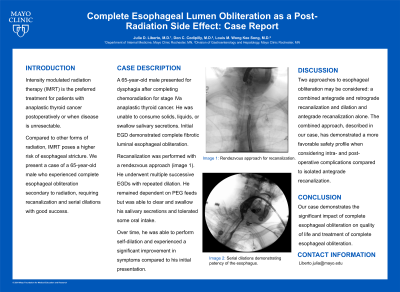Tuesday Poster Session
Category: Esophagus
P4031 - Complete Esophageal Lumen Obliteration as a Post-Radiation Side Effect: A Case Report
Tuesday, October 29, 2024
10:30 AM - 4:00 PM ET
Location: Exhibit Hall E

Has Audio
- JL
Julia Liberto, MD
Mayo Clinic
Rochester, MN
Presenting Author(s)
Julia Liberto, MD, Don C.. Codipilly, MD
Mayo Clinic, Rochester, MN
Introduction: Intensity modulated radiation therapy (IMRT) is the preferred treatment for patients with anaplastic thyroid cancer postoperatively or when disease is unresectable. Compared to other forms of radiation, IMRT poses a higher risk of esophageal stricture. We present a case of a 65-year-old male who experienced complete esophageal obliteration secondary to radiation, requiring recanalization and serial dilations with good success.
Case Description/Methods: A 65-year-old male presented for an evaluation of dysphagia. In the months leading up to presentation, he completed chemoradiation therapy for anaplastic thyroid cancer with paclitaxel and IMRT with near complete response. Post completion of treatment, he was unable to consume solids, liquids, or swallow salivary secretions. To mitigate his significant weight loss secondary to dysphagia, a percutaneous endoscopic gastrostomy (PEG) tube was placed. Initial esophagogastroduodenoscopy (EGD) demonstrated complete fibrotic luminal esophageal obliteration. Recanalization was performed with a rendezvous approach. A standard upper endoscope was advanced into the hypopharynx; a small caliber pediatric upper endoscope was advanced through the PEG tract into the duodenum and was retrogradely advanced into the esophagus. A guidewire was passed through the retrograde endoscope and was utilized to dissect the fibrotic tissue, until the tip of the guidewire was visualized by the antegrade endoscope. Post recanalization, a nasogastric tube was placed to maintain esophageal luminal patency. He underwent multiple successive EGDs with repeated dilation, gradually increasing the size of the dilator as tolerated. He remains dependent on enteral feeds through his PEG tube, but he can now clear and swallow his salivary secretions, a significant improvement compared to initial presentation.
Discussion: Our case demonstrates the significant impact of complete esophageal obliteration on quality of life and treatment of complete esophageal obliteration. Two approaches to esophageal obliteration may be considered: a combined antegrade and retrograde recanalization and dilation (CARD) and antegrade recanalization alone. The combined approach, described in our case, has demonstrated a more favorable safety profile when considering intra- and post-operative complications compared to isolated antegrade recanalization. We discuss the success of endoscopic management to restore esophageal patency in this interesting presentation of complete obliteration.
Disclosures:
Julia Liberto, MD, Don C.. Codipilly, MD. P4031 - Complete Esophageal Lumen Obliteration as a Post-Radiation Side Effect: A Case Report, ACG 2024 Annual Scientific Meeting Abstracts. Philadelphia, PA: American College of Gastroenterology.
Mayo Clinic, Rochester, MN
Introduction: Intensity modulated radiation therapy (IMRT) is the preferred treatment for patients with anaplastic thyroid cancer postoperatively or when disease is unresectable. Compared to other forms of radiation, IMRT poses a higher risk of esophageal stricture. We present a case of a 65-year-old male who experienced complete esophageal obliteration secondary to radiation, requiring recanalization and serial dilations with good success.
Case Description/Methods: A 65-year-old male presented for an evaluation of dysphagia. In the months leading up to presentation, he completed chemoradiation therapy for anaplastic thyroid cancer with paclitaxel and IMRT with near complete response. Post completion of treatment, he was unable to consume solids, liquids, or swallow salivary secretions. To mitigate his significant weight loss secondary to dysphagia, a percutaneous endoscopic gastrostomy (PEG) tube was placed. Initial esophagogastroduodenoscopy (EGD) demonstrated complete fibrotic luminal esophageal obliteration. Recanalization was performed with a rendezvous approach. A standard upper endoscope was advanced into the hypopharynx; a small caliber pediatric upper endoscope was advanced through the PEG tract into the duodenum and was retrogradely advanced into the esophagus. A guidewire was passed through the retrograde endoscope and was utilized to dissect the fibrotic tissue, until the tip of the guidewire was visualized by the antegrade endoscope. Post recanalization, a nasogastric tube was placed to maintain esophageal luminal patency. He underwent multiple successive EGDs with repeated dilation, gradually increasing the size of the dilator as tolerated. He remains dependent on enteral feeds through his PEG tube, but he can now clear and swallow his salivary secretions, a significant improvement compared to initial presentation.
Discussion: Our case demonstrates the significant impact of complete esophageal obliteration on quality of life and treatment of complete esophageal obliteration. Two approaches to esophageal obliteration may be considered: a combined antegrade and retrograde recanalization and dilation (CARD) and antegrade recanalization alone. The combined approach, described in our case, has demonstrated a more favorable safety profile when considering intra- and post-operative complications compared to isolated antegrade recanalization. We discuss the success of endoscopic management to restore esophageal patency in this interesting presentation of complete obliteration.
Disclosures:
Julia Liberto indicated no relevant financial relationships.
Don Codipilly indicated no relevant financial relationships.
Julia Liberto, MD, Don C.. Codipilly, MD. P4031 - Complete Esophageal Lumen Obliteration as a Post-Radiation Side Effect: A Case Report, ACG 2024 Annual Scientific Meeting Abstracts. Philadelphia, PA: American College of Gastroenterology.
